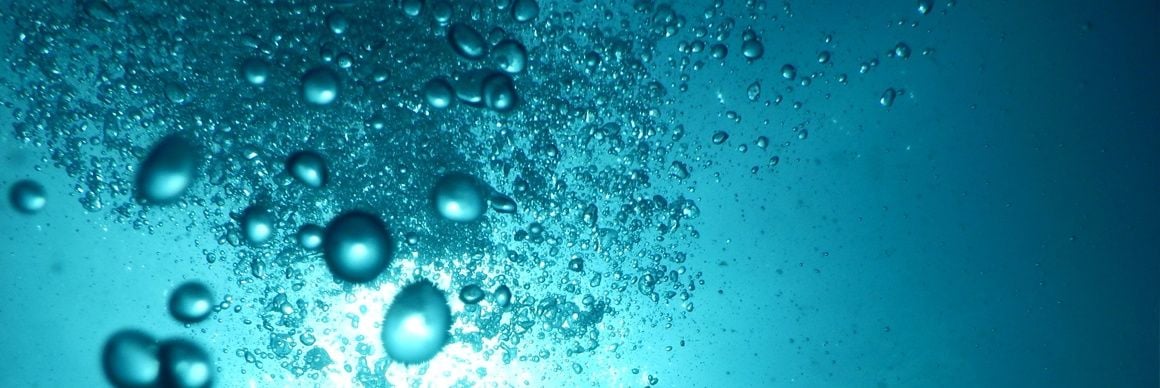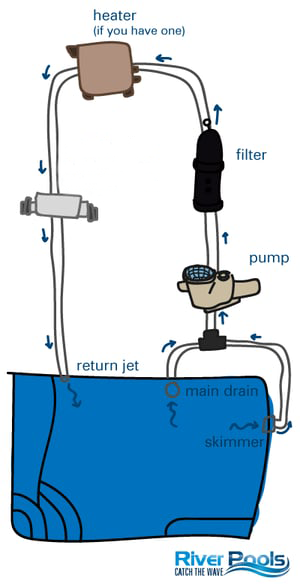Why Do I Have Air Bubbles in My Pool?
Updated: August 11th, 2025 | Published: March 29th, 2019
5 min read
By Guest Author

You designed your dream backyard. The pool, the landscaping, the patio. So much effort, and so worth it. You’ve finally crafted a place that not only looks fantastic, but brings a feeling of togetherness for the ones who matter most to you. It's a beautiful thing.
Except you didn't design the aggressive bubbles shooting out of the returns on the pool walls. So what's up with that?
Why are you getting air bubbles in your swimming pool?
This is a common problem, especially when you're first opening your pool for the season.
A few bubbles in the pool or the pump is normal, but noisy churning and lots of bubbles indicate that you likely have a problem.

Quick recap!
Your pump/filter system works like this.
Your pool pump pulls water from the skimmer(s) and main drain(s), this is called the suction side.
- The water first goes into the strainer pot, a small filter that catches large debris.
- The impeller (a spinning part inside the pump) pushes the water to the filter (sand, cartridge, or D.E.).
- The filter removes dirt, debris, and even bacteria.
- The filtered water then flflows through your plumbing to the heater/chiller (if you have one), then to your chlorinator (salt system or traditional).
- Finally, clean water returns to the pool through the return jets.
Okay, so how does that translate to this issue?
Air bubbles in your pool mean that air is being sucked into the line on the suction side of the pump.
When you first open your pool, you're putting a lot of things back together in the filter system. Nine times out of ten, the issue isn't in the underground plumbing, but in your above ground equipment.
(And above ground issues are often easier to fix because you don't have to dig anything up! Yay!)
River Pools has been a part of the fiberglass/inground pool industry for a long time, and our knowledge and experience along with the chats we have with independent installers across the country allow us to help guide incoming pool buyers and new pool owners from far and wide. And yes, that includes you, even if you end up not buying one of our pools (or even a fiberglass pool)!
So today, we're going to help troubleshoot your pool and get it running smoothly again.
So fret not! We're here to guide you.
What causes air bubbles in swimming pools?
Like we said above, air bubbles in the pool mean that air is being sucked into the line on the suction side of the pump. It's likely happening because of one of these issues:
- The pool water level is too low
- The strainer pot lid isn't on tight or its O-ring is loose/absent/compromised
- The union between the valves and the pump isn't tight or its O-ring is loose/absent/compromised
Good news: replacing an O-ring is a DIY fix that often costs less than $50!

1. Is your water level correct?
First, check how high the water is, specifically, in relation to the skimmers.
If the water level is too low, the skimmer will suck in air and send it to the pump/filter system.
Where should the water level be in a swimming pool?
Based on our experience, we recommend you keep the water at least halfway to three-quarters up the skimmer.
NOTE: For fiberglass pools, never drain your pool below the bottom of the skimmer. You'll most likely void your warranty and may even damage the pool. Always hire a professional to assess the need to drain the pool and perform that work for you.
Pro Tip: Your pool water should be halfway to three-quarters up the skimmer.
2. Is your strainer lid on tight?
Second, check the strainer pot lid.
It should be closed tight. If it's not snug, you'll suck air right through that lid into the pump.
Check the O-ring under the lid:
-
- Turn the pool pump off.
- Take the lid off.
- Make sure the O-ring is there and in good condition.
- Make sure the O-ring is seated.
- Make sure there's no grit or debris that might be obstructing the lid from getting a secure close.
- Place the lid back into position.
Pro Tip: Your strainer lid should have its O-ring in the proper groove, with no damage and no dirt or debris obstructions.
3. Is your pump/valve union on tight?
Third, check the union (fitting) between the pool pump and the valves on the suction side.
Now, this little friend is the most common culprit.
It's where plumbing is taken apart, so it has a pretty high chance for missteps.
Remember the O-ring from the strainer pot lid? Surprise: there's an O-ring here inside the union too!
Check the O-ring at this union:
- Turn the pool pump off.
- Remove the nut over the union.
- Make sure the O-ring is there and in good condition.
- Make sure the O-ring is seated in its groove inside the union.
- Make sure there's no grit or debris preventing the union from closing tightly.
Many times, when you're putting the pump/filter system back together, the union's O-ring will slip out or fall out of its groove. Think about it like a dancer, when you throw it off its groove, bad things happen, like tripping (or in the case of a pool pump/filter system, letting air in).
Reminder: When you tighten your union back up, make sure that the flange (ridge) is flush with the back of the nut. If it's not, something is obstructing the union from fully closing.
Pro Tip: The union between the valves and the pump should have its O-ring in the proper groove, with no damage and no dirt or debris obstructions.
Still have air bubbles in your pool?
If you check all 3 of these things and still have air bubbles, you might have a bigger problem, like a suction-side leak in your plumbing, which would be coming from either your main drain or your skimmer line.
That's more than most pool owners want to handle on their own, so call your friendly neighborhood pool professionals. They'll be happy to help!
Side note: Based on the recommendations of builders across the country, using only rigid PVC pipes and plumbing support consisting of both A) gravel backfill and B) plumbing straps may help prevent plumbing leaks right from the beginning.
Want to know more about proper fiberglass pool maintenance? Our comprehensive fiberglass pool buyer's guide covers every part of the process, from the factory floor to your backyard. It offer tons of tips, tricks, price estimates, and recommendations for long-term care. You can also find some great resources within our fiberglass pool operation/maintenance video library.
Download your fiberglass guide below:
Message from the River Pools Manufacturing Team:
Air bubbles in your pool can be frustrating, but most of the time, the fix is easier than you think. A few small adjustments can have your pool running smoothly again.
At River Pools, we’re passionate about helping pool owners troubleshoot issues quickly so they can get back to enjoying their backyard. Our fiberglass pools are available through independent installers nationwide, and we’re here to share our knowledge whether you already have one of our pools, are exploring your options, or just need a little expert guidance.
If you’re looking for clear answers and practical solutions to keep your pool in top shape, we’d love to help you find the right fit for your space and lifestyle. Check out our blogs and YouTube channel where we cover all the most common questions about pools, and some of the more obscure questions, too.
Made it here but don’t have a fiberglass pool of your own yet? Get in touch with us and we’ll help connect you with an independent installer in your area.
Ready to start the conversation?
Up Next:
How Long Should I Run My Pool Pump?
The Ultimate Guide to Inground Swimming Pool Maintenance
Fiberglass Swimming Pools 101: Manufacturing, Cost, and More
Topics:


